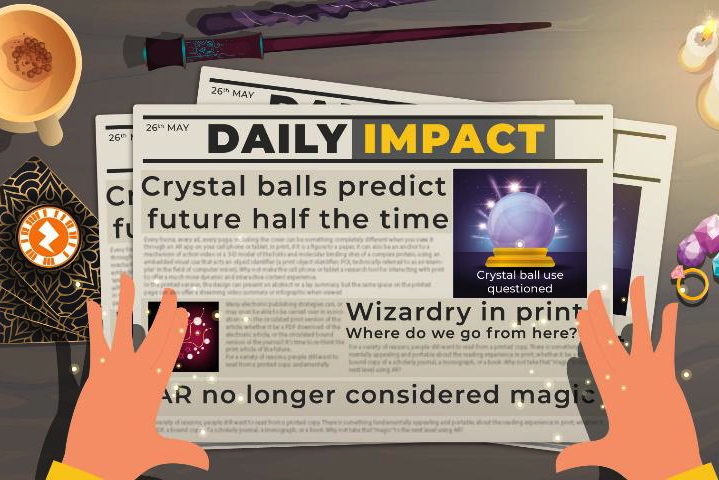Augmented reality offers a new dimension to print

To take full advantage of the AR functionality of this article, download the third-party Zappar app from the Apple App store or Google Play onto your cell phone or tablet and view the article through the app
Donald Samulack investigates the possibilities of augmented reality in academic publishing
We were introduced to the concept of the ‘magical newspaper’, the Daily Prophet, through the Harry Potter series. Did J. K. Rowling know something we didn’t about the future of print?
Can such magic in print only be achieved through wizardry or cinematographic green screens, or are there practical applications to achieve such dynamic content strategies in scholarly print publication today? What if I were to say that much of the dynamic functionality for print is possible today… using augmented reality (AR)?
With a magical newspaper in mind, let’s begin to further reimagine the published ‘article of the future’. We left off with thoughts on the electronification of the research article of record in a non-traditional format to allow for tabs, hyperlinking, and various online navigational strategies – taking advantage of the Internet as a distribution medium.
Then came along annotation overlay capabilities, and the addition of infographics, video imagery, and various forms of supplemental data presentation alongside the electronic article of record.
Many electronic publishing strategies can, or may soon be able to be carried over in association with the circulated print version of the article, whether it be a PDF download of the electronic article, or the circulated bound version of the journal. It’s time to re-think the print article of the future!
For a variety of reasons, people still want to read from a printed copy. There is something fundamentally appealing and portable about the reading experience in print; whether it be a PDF, a bound copy of a scholarly journal, a monograph, or a book. Why not take that 'magic' to the next level using AR?
Through the use of AR in conjunction with a printed copy of a journal article, every frame, every ad, every page, including the cover can be something completely different when you view it through an AR app on your cell phone or tablet. In print, if it is a figure to a paper, it can also be an anchor to a mechanism of action video or a 3D model of the folds and molecular binding sites of a complex protein, using an embedded visual cue that acts as an object identifier (a print object identifier; POI; technically referred to as an ‘exemplar’ in the field of computer vision). Why not make the cell phone or tablet a research tool for interacting with print to offer a much more dynamic and interactive content experience.
In the printed version, the design can present an abstract or a lay summary, but the same space on the printed page can also offer a streaming video summary or infographic when viewed using a designated AR app.
The cover art of the print journal could be connected to actual video footage of the experimental data; perhaps live-cell imaging under immunofluorescence with time-lapse photography. A static image frame in print could represent an anchor for a carrousel of images under AR. A print ad could be an anchor frame for a video or a 3-D pop-up image, allowing much more engagement. Perhaps even supplemental data can be presented or be run in simulation through the AR app. The possibilities are virtually endless.
With custom AR apps, these POIs can be a small portion of the image itself, or an element embedded in the image (the latter strategy has been implemented for production simplicity in the framed image on this page). Think of POIs as DOIs (digital object identifiers) – they essentially perform the same function. Instead of hyperlinking to another web page, a POI anchors a designated digital AR overlay to the printed material through the use of an AR app; much like a QR code allows a link to a web page – the difference is that the AR app is designed to anchor the digitally streamed material to the visual space of the designated printed material.
All of these strategies not only offer ‘dynamic functionality’ to the printed journal article, they offer stopping power! At Cactus Communications, through our Impact Science services, we are developing these tools for specific publisher strategies, keeping researchers and industry advertisers in mind, to allow key digital aspects of scholarly information to be accessed through various print mediums.
Donald Samulack is president of US Operations at Editage/Cactus Communications






